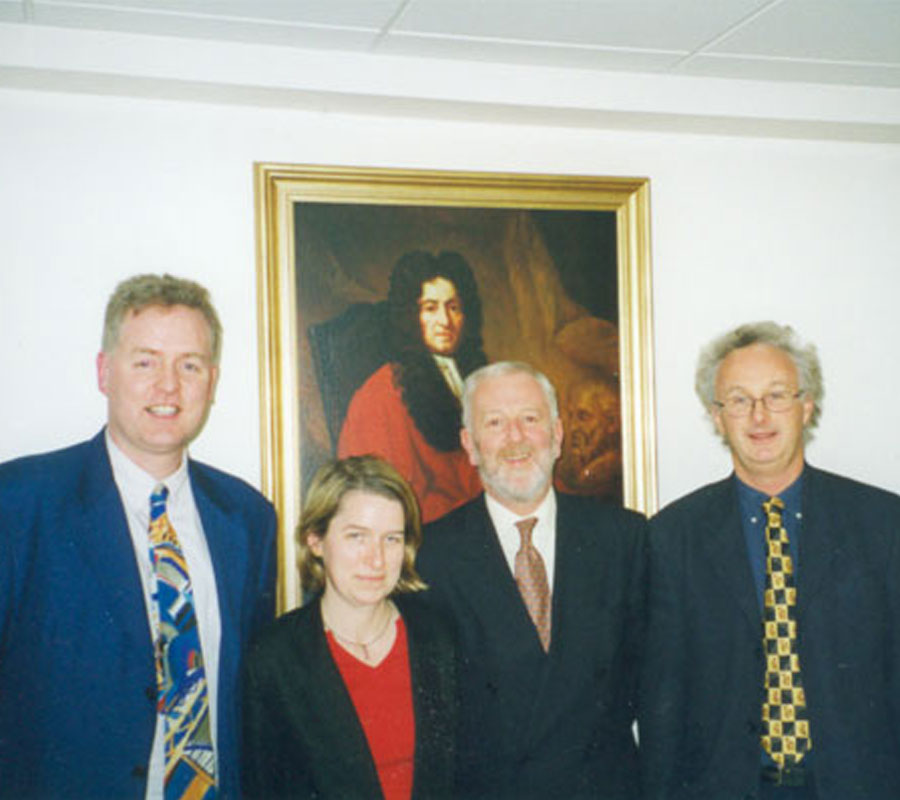About Us
History
The HAI began as a ” Blood Club” in 1978. The first meeting was convened by Prof Ernest Egan, then newly appointed to Galway and one of only a handful of consultant hematologists working in Ireland.
The Blood Club met annually and gradually expanded. Membership was informal and initially meetings attracted mainly qualified haematology doctors and doctors in training. In 1999, the group was formalised and coalesced under the title of “Haematology Association of Ireland”. A constitution and committee was agreed under the first president Prof Shaun McCann, ably assisted by vice president Curly Morris, Mary Frances McMullin Secretary/Treasurer and Mark Lawlor, Scientific Secretary. Committee members at that time included: President: Prof. Shaun McCann, Vice-President: Dr T.C. M. Morris, Scientific Secretary: Dr Mark Lawler, Secretary/Treasurer: Dr Mary Frances McMullin. Other Committee Members elected at that meeting were: Dr Michael Madden, Dr Helen Enright, Dr Margaret Murray, Dr Aengus O’Marcaigh, Dr Kieran Morris, Dr Owen Smith, Dr T. Lappin and Dr Anne Kyle.
HAI now meets annually for our scientific meeting with committee meeting during the year to plan the annual meeting and run the society. The committee members are drawn from both sides of the border and traditionally the Association’s president rotates between the northern and southern members. Members will be aware that meetings move around the country and meeting venue planning occurs three years in advance.
Who was Bill O’Connell?
Each year the HAI attracts a high profile international expert for the O’Connell lecture. This O’Connell Memorial Lecture allows to sample the future in a given area of haematology while commemorating the past and celebration the beginnings of haematology in Ireland.
Bill O’Connell came from Portlaoise where his father was the county surgeon. The eldest of a large family, his time in Clongowes typified the success he was to achieve in later life. Bill was on the first fifteen as well as the athletic team. He also excelled academically and undertook medical studies in UCD. While there he stayed in the Hall in Hatch Street. Here he won notoriety for his habit at the end of a night’s dancing at 4.00am he settled down to two hours study!
In an eloquent tribute Seamus Cahalane has described their student years: “As a medical student he seemed to have more gravitas than the generality of his fellows and eschewed most of our aimless society preoccupations. He had taken a year off for the BSc degree in anatomy and physiology, and joined our class in the middle forties. He was straight away in the upper echelons scholastically and was soon the constant companion of the quiet, slim dark haired Pauline Dunn. Pauline’s brother, Fr Joe Dunn of Radharc, recalled the family’s bemusement at the high academic expectations of their sisters suitor seeing that he spent so much time in and around their home. The truth was that each was the other’s mentor and study assistant in the medical curriculum.
Having qualified, Bill worked in the Mater, got an MSc and a traveling fellowship and (now married to Pauline) went to the City Hospital, Boston. Here Bill settled on haematology as his speciality.
They returned to Dublin and both set up practice in Baggot Street. This was an unusual venture: to establish and equip your own laboratory in the basement of a Georgian house in Dublin in the late 1950s without formal attachment to any hospital was an act of courage and of faith. When somebody said to another pathologist that Bill was visiting half the hospitals in Dublin the cynical reply was “Yes, but is he being paid?” No he was not: a few honoraria but no contracts! Yet the work came to Bill – he was after all the only fully qualified and equipped haematologist in the Republic. He retained his links with UCD where he became lecturer in osteology in the Department of Anatomy – something he continued for thirty years. Dr Liam O’Connell was then appointed Consultant Haematologist to St. Vincent’s Hospital.
Another role this many faceted man assumed was that of involvement in the politics of his profession. To quote Seamus Cahalane again: “Bill O’Connell became heavily involved in medical politics and worked as intensively at this as he did in his practice. His interest stemmed particularly from his fathers role in the early IMA but also from his clear insight into the need to preserve professional integrity in the face of growing central administrative intrusion. Thus he took on the most demanding role in the organisation, that of Chairman of Council, which increased the orbit of his ‘peripathesis’. The unity of the professional body was ultimately fragmented by sectional interests and Bill ceased to be active in the cause which he and his colleagues had so diligently served”.
Above all Dr O’Connell’s colleagues and contemporaries, remember him as a person; the muscular, tweed-clad figure, the pipe he smoked, the confident, deep tones never uncertain about what he said or advised, the gleam of humour when somebody’s faults or foibles were mentioned but never condemned. Dr Pauline O’Connell attends the HAI annual academic meeting to present the guest speaker with a memorial gift from the society.
Dr Liam (Bill) O’Connell M.D., MSc, FRCPI, died in August 1995.
